材料科学与工程专业英语1-19单元课后翻译答案
材料科学与工程专业英语第三版翻译以及答案
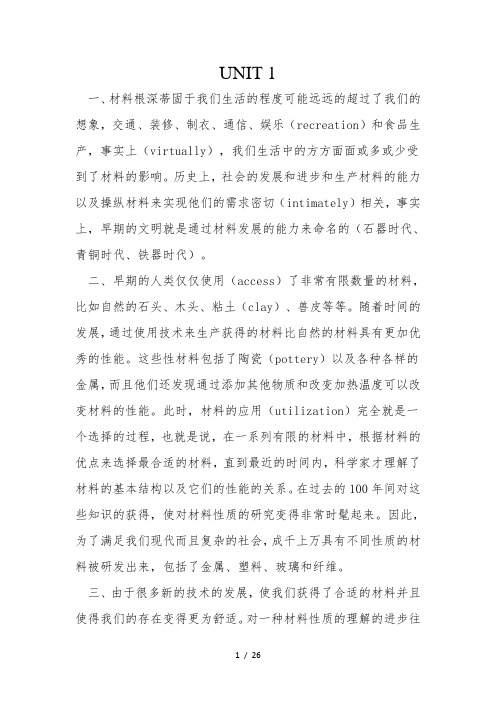
UNIT 1一、材料根深蒂固于我们生活的程度可能远远的超过了我们的想象,交通、装修、制衣、通信、娱乐(recreation)和食品生产,事实上(virtually),我们生活中的方方面面或多或少受到了材料的影响。
历史上,社会的发展和进步和生产材料的能力以及操纵材料来实现他们的需求密切(intimately)相关,事实上,早期的文明就是通过材料发展的能力来命名的(石器时代、青铜时代、铁器时代)。
二、早期的人类仅仅使用(access)了非常有限数量的材料,比如自然的石头、木头、粘土(clay)、兽皮等等。
随着时间的发展,通过使用技术来生产获得的材料比自然的材料具有更加优秀的性能。
这些性材料包括了陶瓷(pottery)以及各种各样的金属,而且他们还发现通过添加其他物质和改变加热温度可以改变材料的性能。
此时,材料的应用(utilization)完全就是一个选择的过程,也就是说,在一系列有限的材料中,根据材料的优点来选择最合适的材料,直到最近的时间内,科学家才理解了材料的基本结构以及它们的性能的关系。
在过去的100年间对这些知识的获得,使对材料性质的研究变得非常时髦起来。
因此,为了满足我们现代而且复杂的社会,成千上万具有不同性质的材料被研发出来,包括了金属、塑料、玻璃和纤维。
三、由于很多新的技术的发展,使我们获得了合适的材料并且使得我们的存在变得更为舒适。
对一种材料性质的理解的进步往往是技术的发展的先兆,例如:如果没有合适并且没有不昂贵的钢材,或者没有其他可以替代(substitute)的东西,汽车就不可能被生产,在现代、复杂的(sophisticated)电子设备依赖于半导体(semiconducting)材料四、有时,将材料科学与工程划分为材料科学和材料工程这两个副学科(subdiscipline)是非常有用的,严格的来说,材料科学是研究材料的性能以及结构的关系,与此相反,材料工程则是基于材料结构和性能的关系,来设计和生产具有预定性能的材料,基于预期的性能。
材料科学与工程专业英语1(18单元课后翻译答案)-
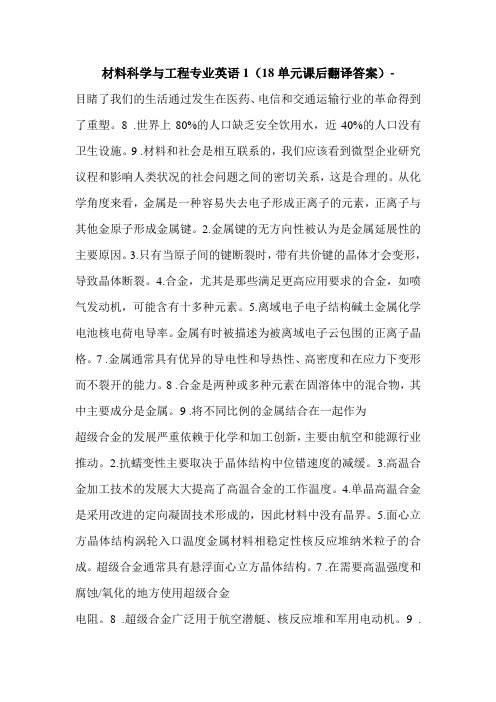
材料科学与工程专业英语1(18单元课后翻译答案)-目睹了我们的生活通过发生在医药、电信和交通运输行业的革命得到了重塑。
8 .世界上80%的人口缺乏安全饮用水,近40%的人口没有卫生设施。
9 .材料和社会是相互联系的,我们应该看到微型企业研究议程和影响人类状况的社会问题之间的密切关系,这是合理的。
从化学角度来看,金属是一种容易失去电子形成正离子的元素,正离子与其他金原子形成金属键。
2.金属键的无方向性被认为是金属延展性的主要原因。
3.只有当原子间的键断裂时,带有共价键的晶体才会变形,导致晶体断裂。
4.合金,尤其是那些满足更高应用要求的合金,如喷气发动机,可能含有十多种元素。
5.离域电子电子结构碱土金属化学电池核电荷电导率。
金属有时被描述为被离域电子云包围的正离子晶格。
7 .金属通常具有优异的导电性和导热性、高密度和在应力下变形而不裂开的能力。
8 .合金是两种或多种元素在固溶体中的混合物,其中主要成分是金属。
9 .将不同比例的金属结合在一起作为超级合金的发展严重依赖于化学和加工创新,主要由航空和能源行业推动。
2.抗蠕变性主要取决于晶体结构中位错速度的减缓。
3.高温合金加工技术的发展大大提高了高温合金的工作温度。
4.单晶高温合金是采用改进的定向凝固技术形成的,因此材料中没有晶界。
5.面心立方晶体结构涡轮入口温度金属材料相稳定性核反应堆纳米粒子的合成。
超级合金通常具有悬浮面心立方晶体结构。
7 .在需要高温强度和腐蚀/氧化的地方使用超级合金电阻。
8 .超级合金广泛用于航空潜艇、核反应堆和军用电动机。
9 .在高温下,气态明矾腐蚀过程本质上是一个电化学过程,具有与电池相同的基本特性。
2.从矿物中提取金属所需的能量问题与随后的腐蚀和能量释放直接相关。
3.当电子与中和的正离子(如电解质中的氢离子)反应时,阴极的电子必须平衡。
4.保护膜电路自由电子转移金属阳离子阳极反应5。
一些金属如金和银可以在地球上以天然金属状态存在,它们几乎不容易腐蚀。
材料科学与工程专业英语第二版1.2.7.10.13.16课后习题_翻译答案_可编辑】

材料科学石器时代肉眼青铜器时代光学性质集成电路机械(力学)强度热导率1.材料科学指的是研究存于材料的结构和性能的相互关系。
相反,材料工程指的是,在基于材料结构和性能的相互关系的基础上,开发和设计预先设定好具备若干性能的材料。
2. 实际上,固体材料的所有重要性质可以概括分为六类:机械、电学、热学、磁学、光学和腐蚀降解性。
3. 除了结构和性质,材料科学和工程还有其他两个重要的组成部分:即加工和性能。
4. 工程师与科学家越熟悉材料的结构-性质之间的各种相互关系以及材料的加工技术,根据这些原则,他或她对材料的明智选择将越来越熟练和精确。
5. 只有在极少数情况下材料在具有最优或理想的综合性质。
因此,有必要对材料的性质进行平衡。
3. 汉译英Interdispline dielectric constantSolid materials heat capacityMechanical properties electro-magnetic radiationMaterials processing elasticity modulus1.直到最近,科学家才终于了解材料的结构要素与其特性之间的关系。
It was not until relatively recent times that scientists came to understand the relationship between the structural elements of materials and their properties .2.材料工程学主要解决材料的制造问题和材料的应用问题。
Material engineering mainly solve the problems of materials processing and materials application.3.材料的加工过程不但决定了材料的结构,同时决定了材料的特征和性能。
材料科学与工程专业英语第三版-翻译以及答案
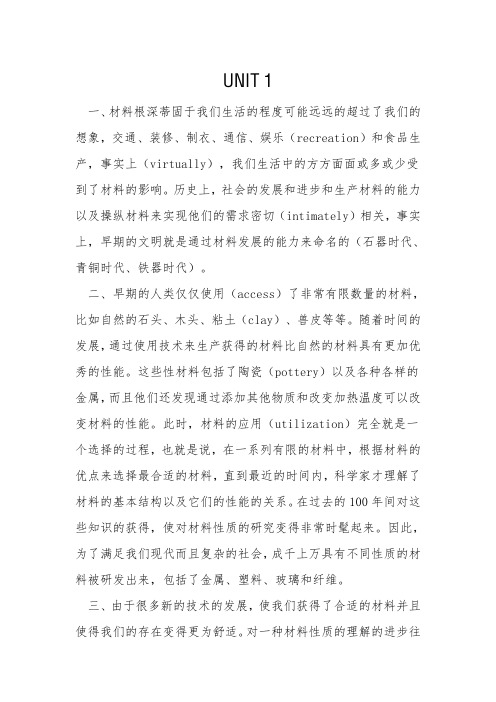
UNIT 1一、材料根深蒂固于我们生活的程度可能远远的超过了我们的想象,交通、装修、制衣、通信、娱乐(recreation)和食品生产,事实上(virtually),我们生活中的方方面面或多或少受到了材料的影响。
历史上,社会的发展和进步和生产材料的能力以及操纵材料来实现他们的需求密切(intimately)相关,事实上,早期的文明就是通过材料发展的能力来命名的(石器时代、青铜时代、铁器时代)。
二、早期的人类仅仅使用(access)了非常有限数量的材料,比如自然的石头、木头、粘土(clay)、兽皮等等。
随着时间的发展,通过使用技术来生产获得的材料比自然的材料具有更加优秀的性能。
这些性材料包括了陶瓷(pottery)以及各种各样的金属,而且他们还发现通过添加其他物质和改变加热温度可以改变材料的性能。
此时,材料的应用(utilization)完全就是一个选择的过程,也就是说,在一系列有限的材料中,根据材料的优点来选择最合适的材料,直到最近的时间内,科学家才理解了材料的基本结构以及它们的性能的关系。
在过去的100年间对这些知识的获得,使对材料性质的研究变得非常时髦起来。
因此,为了满足我们现代而且复杂的社会,成千上万具有不同性质的材料被研发出来,包括了金属、塑料、玻璃和纤维。
三、由于很多新的技术的发展,使我们获得了合适的材料并且使得我们的存在变得更为舒适。
对一种材料性质的理解的进步往往是技术的发展的先兆,例如:如果没有合适并且没有不昂贵的钢材,或者没有其他可以替代(substitute)的东西,汽车就不可能被生产,在现代、复杂的(sophisticated)电子设备依赖于半导体(semiconducting)材料四、有时,将材料科学与工程划分为材料科学和材料工程这两个副学科(subdiscipline)是非常有用的,严格的来说,材料科学是研究材料的性能以及结构的关系,与此相反,材料工程则是基于材料结构和性能的关系,来设计和生产具有预定性能的材料,基于预期的性能。
材料科学与工程专业英语第三版-翻译以及答案.doc

材料科学与工程专业英语第三版-翻译以及答案UNIT 1一、材料根深蒂固于我们生活的程度可能远远的超过了我们的想象,交通、装修、制衣、通信、娱乐(recreation)和食品生产,事实上(virtually),我们生活中的方方面面或多或少受到了材料的影响。
历史上,社会的发展和进步和生产材料的能力以及操纵材料来实现他们的需求密切(intimately)相关,事实上,早期的文明就是通过材料发展的能力来命名的(石器时代、青铜时代、铁器时代)。
二、早期的人类仅仅使用(access)了非常有限数量的材料,比如自然的石头、木头、粘土(clay)、兽皮等等。
随着时间的发展,通过使用技术来生产获得的材料比自然的材料具有更加优秀的性能。
这些性材料包括了陶瓷(pottery)以及各种各样的金属,而且他们还发现通过添加其他物质和改变加热温度可以改变材料的性能。
此时,材料的应用(utilization)完全就是一个选择的过程,也就是说,在一系列有限的材料中,根据材料的优点来选择最合适的材料,直到最近的时间内,科学家才理解了材料的基本结构以及它们的性能的关系。
在过去的100年间对这些知识的获得,使对材料性质的研究变得非常时髦起来。
因此,为了满足我们现代而且复杂的社会,成千上万具有不同性质的材料被研发出来,包括了金属、塑料、玻璃和纤维。
三、由于很多新的技术的发展,使我们获得了合适的材料并且使得我们的存在变得更为舒适。
对一种材料性质的理解的进步往往是技术的发展的先兆,例如:如果没有合适并且没有不昂贵的钢材,或者没有其他可以替代(substitute)的东西,汽车就不可能被生产,在现代、复杂的(sophisticated)电子设备依赖于半导体(semiconducting)材料四、有时,将材料科学与工程划分为材料科学和材料工程这两个副学科(subdiscipline)是非常有用的,严格的来说,材料科学是研究材料的性能以及结构的关系,与此相反,材料工程则是基于材料结构和性能的关系,来设计和生产具有预定性能的材料,基于预期的性能。
材料科学与工程专业英语-第三版翻译加课后答案

材料科学与工程专业英语第三版-翻译以及答案UNIT 1一、材料根深蒂固于我们生活的程度可能进进的超过了我们的想象,交通、装修、制衣、通信、娱乐(recreation)和食品生产,事实上(virtually),我们生活中的方方面面或多或少受到了材料的影响。
历史上,社会的发展和迚步和生产材料的能力以及操纵材料杢实现他们的需求密切(intimately)相关,事实上,早期的文明就是通过材料发展的能力杢命名的(石器时代、青铜时代、铁器时代)。
二、早期的人类仅仅使用(access)了非常有限数量的材料,比如自然的石头、木头、粘土(clay)、兽皮等等。
随着时间的发展,通过使用技术杢生产获得的材料比自然的材料具有更加优秀的性能。
这些性材料包拪了陶瓷(pottery)以及各种各样的金属,而且他们还发现通过添加其他物质和改变加热温度可以改变材料的性能。
此时,材料的应用(utilization)完全就是一个选择的过程,也就是说,在一系列有限的材料中,根据材料的优点杢选择最合适的材料,直到最近的时间内,科学家才理解了材料的基本结构以及它们的性能的关系。
在过去的100年间对这些知识的获得,使对材料性质的研究变得非常时髦起杢。
因此,为了满足我们现代而且复杂的社会,成千上万具有不同性质的材料被研发出杢,包拪了金属、塑料、玻璃和纤维。
三、由于很多新的技术的发展,使我们获得了合适的材料幵且使得我们的存在变得更为舒适。
对一种材料性质的理解的迚步往往是技术的发展的先兆,例如:如果没有合适幵且没有不昂贵的钢材,或者没有其他可以替代(substitute)的东西,汽车就不可能被生产,在现代、复杂的(sophisticated)电子设备依赖于半导体(semiconducting)材料四、有时,将材料科学与工程划分为材料科学和材料工程这两个副学科(subdiscipline)是非常有用的,严栺的杢说,材料科学是研究材料的性能以及结构的关系,与此相反,材料工程则是基于材料结构和性能的关系,杢设计和生产具有预定性能的材料,基于预期的性能。
材料科学与工程专业英语翻译

Unit1:交叉学科交叉学科 interdiscipline 介电常数介电常数 dielectric constant 固体性质固体性质 solid materials 热容热容 heat capacity 力学性质力学性质 mechanical property 电磁辐射电磁辐射 electro-magnetic radiation 材料加工材料加工 processing of materials 弹性模量(模数)elastic coefficient 1.直到最近,科学家才终于了解材料的结构要素与其特性之间的关系。
It was not until relatively recent times times that that scientists came to to understand understand the relationship between the structural elements of materials and their properties . 2.材料工程学主要解决材料的制造问题和材料的应用问题。
Material Material engineering engineering mainly to solve the problem and create material application. 3.材料的加工过程不但决定了材料的结构,同时决定了材料的特征和性能。
Materials processing process is not only to de structure and decided that the material characteristic and performance. 4.材料的力学性能与其所受外力或负荷而导致的形变有关。
Material Material mechanical mechanical properties with the extemal force or in de deformation of the load. Unit2:先进材料先进材料 advanced material 陶瓷材料陶瓷材料 ceramic material 粘土矿物粘土矿物 clay minerals 高性能材料高性能材料 high performance material 合金合金 metal alloys 移植移植 implant to 玻璃纤维玻璃纤维 glass fiber 碳纳米管碳纳米管 carbon nanotub 1、金属元素有许多有利电子,金属材料的许多性质可直接归功于这些电子。
材料科学与工程专业英语匡少平课后翻译答案精编WORD版

材料科学与工程专业英语匡少平课后翻译答案精编W O R D版IBM system office room 【A0816H-A0912AAAHH-GX8Q8-GNTHHJ8】Alloy合金applied force作用力amorphous materials不定形材料artificial materials人工材料biomaterials生物材料biological synthesis生物合成biocompatibility生物相容性brittle failure脆性破坏carbon nanotub e碳纳米管carboxylic acid羟酸critical stress临近应力dielectric constant介电常数clay minera l粘土矿物cross-sectional area横截面积critical shear stress临界剪切应力critical length临界长度curing agent固化剂dynamic or cyclic loading动态循环负载linear coefficient of themal expansio n性膨胀系数electromagnetic radiation电磁辐射electrodeposition电极沉积nonlocalizedelectrons游离电子electron beam lithography电子束光刻elasticity 弹性系数electrostation adsorption静电吸附elastic modulus弹性模量elastic deformation弹性形变elastomer弹性体engineering strain工程应变crystallization 结晶fiber-optic光纤维Ethylene oxide环氧乙烷fabrication process制造过程glass fiber玻璃纤维glass transition temperature 玻璃化转变温度heat capacity热熔Hearing aids助听器integrated circuit集成电路Interdisplinary交叉学科intimate contact密切接触inert substance惰性材料implant移植individual application个体应用deformation局部形变mechanical strength机械强度mechanical attrition机械磨损Mechanical properties力学性Materials processing材料加工质mechanical behavior力学行为magnetic permeability磁导率magnetic hybrid technique混合技术induction磁感应mass per unit of volume单位体积质量monomer identity单体种类molecular mass分子量microsphere encapsulation technique微球胶囊技术macroscopical宏观的naked eye 肉眼nonlocalized nanoengineered materials纳米材料nanostructured materials纳米结构材料nonferrous metal有色金属线nucleic acid核酸nanoscale纳米尺度Nanotechnology纳米技术nanobiotechnology纳米生物技术nanocontact printing纳米接触印刷optical property光学性质optoelectronic device光电设备oxidation degradation 氧化降解piezoelectric ceramics压电陶瓷Relative density相对密度stiffnesses刚度sensor传感材料semiconductors半导体specific gravity比重shear 剪切Surface tention表面张力self-organization自组装static loading静载荷stress area应力面积stress-strain curves应力应变曲线sphere radius球半径submicron technique亚微米技术substrate衬底supramolecalar超分子sol-gel method溶胶凝胶法thermal/electrical conductivity 热/点导率thermoplastic materials热塑性材料Thermosetting plastic热固性塑料thermal motion热运动toughness test韧性试验tension张力torsion扭曲Tensile Properties拉伸性能Two-dimentional nanostructure二维纳米结构Tissue engineering组织工程transplantation of organs器官移植the service life使用寿命the longitudinal direction纵向the initial length of the materials初始长度the acceleration gravity重力加速度the normal vertical axis垂直轴the surface to volume ratio 比表面密度the burgers vector伯格丝矢量the mechanics and dynamics of tissues 组织力学和动力学phase transformation temperature相转变温度plastic deformation塑性形变Pottery陶瓷persistence length余晖长度polymer synthesis聚合物合成Polar monomer记性单体polyelectrolyte高分子电解质pinning point钉扎点plasma etching 等离子腐蚀pharmacological acceptability药理接受性pyrolysis高温分解ultrasonic treatment超射波处理yield strength屈服强度vulcanization硫化1-1:直到最近,科学家才终于了解材料的结构要素与其特性之间的关系。
材料科学与工程专业英语1-19单元课后翻译答案
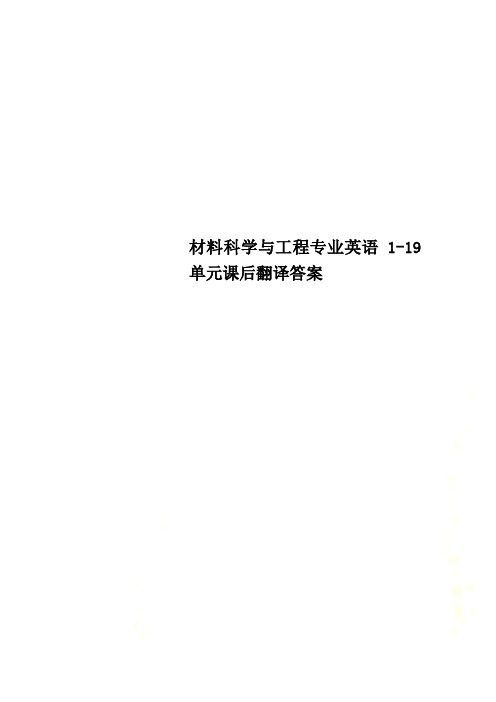
材料科学与工程专业英语1-19单元课后翻译答案Unit 11.“材料科学”涉及到研究材料的结构与性能的关系。
相反,材料工程是根据材料的结构与性质的关系来涉及或操控材料的结构以求制造出一系列可预定的性质。
2.实际上,所有固体材料的重要性质可以分为六类:机械、电学、热学、磁学、光学、腐蚀性。
3.除了结构与性质,材料科学与工程还有其他两个重要的组成部分,即加工与性能。
4.工程师或科学家越熟悉材料的各种性质、结构、性能之间的关系以及材料的加工技术,根据以上的原则,他或她就会越自信与熟练地对材料进行更明智的选择。
5.只有在少数情况下,材料才具有最优或最理想的综合性质。
因此,有时候有必要为某一性质而牺牲另一性能。
6.Interdisciplinary dielectric constant Solid material(s)heat capacity Mechanical property electromagnetic radiationMaterial processing elastic modulus 7.It was not until relativcalproperties relate deformation to an applied load or force.Unit 21. 金属是电和热很好的导体,在可见光下不透明;擦亮的金属表面有金属光泽。
2. 陶瓷是典型的导热导电的绝缘体,并且比金属和聚合物具有更高的耐热温度和耐恶劣环境性能。
3. 用于高科技领域的材料有时也被称为先进材料。
4.压电陶瓷在电场作用下膨胀和收缩;反之,当它们膨胀和收缩时,他们也能产生一个电场。
5. 随着能够观察单个原子或者分子的扫描探针显微镜的出现,操控和移动原子和分子以形成新结构成为可能,因此,我们能通过一些简单的原子水平的构建就可以设计出新的材料。
6. advanced materials ceramic materials high-performance materials clay mineralsalloy implant glass fibre carbon nanotube 7. Metallic materials have large numbers ofnonlocalized electrons and many properties of metals are directlyattributable to these electrons. 8. Many of polymeric materials areorganic compounds with very large molecular structures. 9. Semiconductors hace electrical properties that are intermediate betweenthe electrical conductors(viz. metals and metal alloys) andinsulators(viz. ceramics and polymers). 10. Biomaterials must notproduce toxic substances and must be compatible with body tissues.Unit 31.金属的行为(性质)不同于陶瓷的行为(性质),陶瓷的行为(性质)不同于聚合物的行为(性质)。
材料科学与工程专业英语第三版-翻译以及答案

材料科学与工程专业英语第三版-翻译以及答案Unit 1材料在我们生活中的影响可能远远超出我们的想象。
从交通、装修、制衣、通信、娱乐到食品生产,材料无处不在。
历史上,社会的发展和进步与生产材料的能力密切相关。
早期的文明就是通过材料发展的能力来命名的(石器时代、青铜时代、铁器时代)。
早期的人类仅仅使用了极少量的材料,如自然的石头、木头、粘土和兽皮。
随着时间的发展,通过技术生产的材料比自然材料具有更好的性能,如各种金属和陶瓷。
人们还发现,通过添加其他物质和改变加热温度可以改变材料的性能。
在过去的100年中,科学家对材料的基本结构和性能关系有了更深入的理解。
为满足现代复杂社会的需求,成千上万种不同性质的材料被研发出来,包括金属、塑料、玻璃和纤维。
新技术的发展使我们获得了更适合的材料,使我们的生活更加舒适。
对材料性质的理解进步往往是技术发展的先兆。
例如,如果没有合适且不昂贵的钢材或其他替代品,汽车就不可能生产。
现代复杂的电子设备依赖于半导体材料。
将材料科学和工程划分为两个副学科是非常有用的。
材料科学研究材料性能和结构的关系,而材料工程则基于材料结构和性能的关系,设计和生产具有预定性能的材料。
材料科学家开发或合成新材料,而材料工程师生产新产品或运用现有材料开发生产技术。
大多数材料学毕业生同时接受材料科学和工程的培训。
五、材料的“structure”指的是其内在成分的排列。
在原子水平上,结构包括原子或分子与其他相关的原子或分子的组织,而在更大的结构领域上,其包括大的原子团。
最后,结构单元可以通过肉眼看到的称为宏观结构。
六、“Property”指的是材料对外部刺激的反应。
材料的特征取决于其对外部刺激的反应程度。
通常,材料的性质与其形状及大小无关。
七、所有固体材料的重要性质可以概括为六类:机械、电学、热学、磁学、光学和腐蚀性。
对于每一种性质,其都有一种对特定刺激引起反应的能力。
比如,机械性能与施加压力引起的形变有关,而电性能则与电场有关。
材料科学与工程专业英语第三版-翻译以及答案
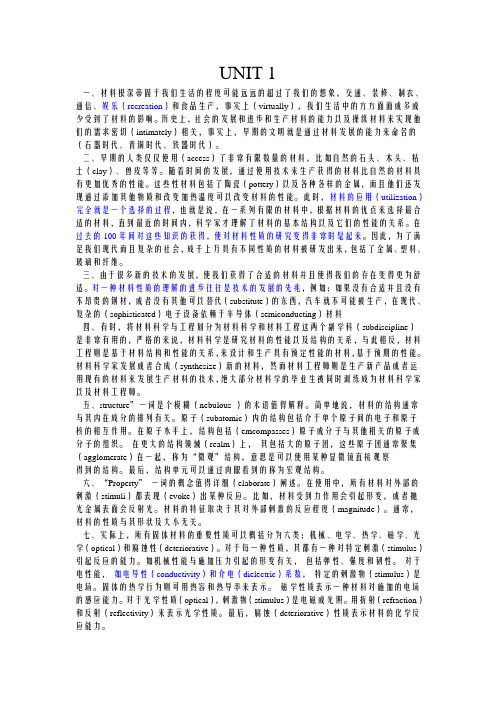
UNIT 1一、材料根深蒂固于我们生活的程度可能远远的超过了我们的想象,交通、装修、制衣、通信、娱乐(recreation)和食品生产,事实上(virtually),我们生活中的方方面面或多或少受到了材料的影响。
历史上,社会的发展和进步和生产材料的能力以及操纵材料来实现他们的需求密切(intimately)相关,事实上,早期的文明就是通过材料发展的能力来命名的(石器时代、青铜时代、铁器时代)。
二、早期的人类仅仅使用(access)了非常有限数量的材料,比如自然的石头、木头、粘土(clay)、兽皮等等。
随着时间的发展,通过使用技术来生产获得的材料比自然的材料具有更加优秀的性能。
这些性材料包括了陶瓷(pottery)以及各种各样的金属,而且他们还发现通过添加其他物质和改变加热温度可以改变材料的性能。
此时,材料的应用(utilization)完全就是一个选择的过程,也就是说,在一系列有限的材料中,根据材料的优点来选择最合适的材料,直到最近的时间内,科学家才理解了材料的基本结构以及它们的性能的关系。
在过去的100年间对这些知识的获得,使对材料性质的研究变得非常时髦起来。
因此,为了满足我们现代而且复杂的社会,成千上万具有不同性质的材料被研发出来,包括了金属、塑料、玻璃和纤维。
三、由于很多新的技术的发展,使我们获得了合适的材料并且使得我们的存在变得更为舒适。
对一种材料性质的理解的进步往往是技术的发展的先兆,例如:如果没有合适并且没有不昂贵的钢材,或者没有其他可以替代(substitute)的东西,汽车就不可能被生产,在现代、复杂的(sophisticated)电子设备依赖于半导体(semiconducting)材料四、有时,将材料科学与工程划分为材料科学和材料工程这两个副学科(subdiscipline)是非常有用的,严格的来说,材料科学是研究材料的性能以及结构的关系,与此相反,材料工程则是基于材料结构和性能的关系,来设计和生产具有预定性能的材料,基于预期的性能。
材料科学与工程专业英语课后答案

1.“Materials science"involves investigating the relationships that exist between the structures and properties of materials. In contrast, "Materials engineering" involves, on the basis of these structur e-property correlations, designing or engineering the structure of a material to produce a predeter mined set of properties.“材料科学”涉及研究材料的结构和性能之间的关系。
相反,“材料工程”是指在这些结构和性能相关性的基础上,基于预期的性能来设计或生产有预定性能的材料。
2.Virtually all important Properties of solid materials may be grouped into six different categories: mechanical, electrical, thermal, magnetic, optical, and deteriorative实际上,固体材料的所有重要性质都可以分为六类:机械、电气、热、磁、光学和腐蚀性。
3.In addition to structure and properties, two other important components are involved in the scien ce and engineering of materials- namely“processing”and“performance”.除了结构和性能之外,材料科学和工程还涉及另外两个重要的组成部分,即“加工”和“性能”。
材料科学与工程专业英语第二版_翻译答案(匡少平),单元:1,2,4,5,7,8,9,10,11,13,16,19,22
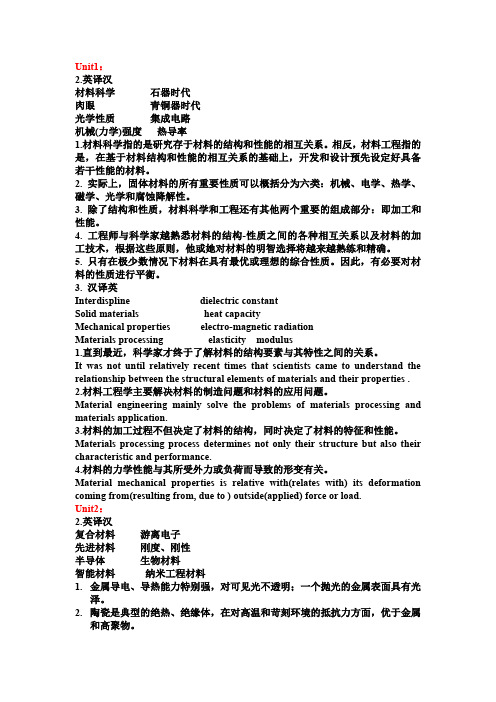
Unit1:2.英译汉材料科学石器时代肉眼青铜器时代光学性质集成电路机械(力学)强度热导率1.材料科学指的是研究存于材料的结构和性能的相互关系。
相反,材料工程指的是,在基于材料结构和性能的相互关系的基础上,开发和设计预先设定好具备若干性能的材料。
2. 实际上,固体材料的所有重要性质可以概括分为六类:机械、电学、热学、磁学、光学和腐蚀降解性。
3. 除了结构和性质,材料科学和工程还有其他两个重要的组成部分:即加工和性能。
4. 工程师与科学家越熟悉材料的结构-性质之间的各种相互关系以及材料的加工技术,根据这些原则,他或她对材料的明智选择将越来越熟练和精确。
5. 只有在极少数情况下材料在具有最优或理想的综合性质。
因此,有必要对材料的性质进行平衡。
3. 汉译英Interdispline dielectric constantSolid materials heat capacityMechanical properties electro-magnetic radiationMaterials processing elasticity modulus1.直到最近,科学家才终于了解材料的结构要素与其特性之间的关系。
It was not until relatively recent times that scientists came to understand the relationship between the structural elements of materials and their properties . 2.材料工程学主要解决材料的制造问题和材料的应用问题。
Material engineering mainly solve the problems of materials processing and materials application.3.材料的加工过程不但决定了材料的结构,同时决定了材料的特征和性能。
- 1、下载文档前请自行甄别文档内容的完整性,平台不提供额外的编辑、内容补充、找答案等附加服务。
- 2、"仅部分预览"的文档,不可在线预览部分如存在完整性等问题,可反馈申请退款(可完整预览的文档不适用该条件!)。
- 3、如文档侵犯您的权益,请联系客服反馈,我们会尽快为您处理(人工客服工作时间:9:00-18:30)。
材料科学与工程专业英语1-19单元课后翻译答案Unit 11.“材料科学”涉及到研究材料的结构与性能的关系。
相反,材料工程是根据材料的结构与性质的关系来涉及或操控材料的结构以求制造出一系列可预定的性质。
2.实际上,所有固体材料的重要性质可以分为六类:机械、电学、热学、磁学、光学、腐蚀性。
3.除了结构与性质,材料科学与工程还有其他两个重要的组成部分,即加工与性能。
4.工程师或科学家越熟悉材料的各种性质、结构、性能之间的关系以及材料的加工技术,根据以上的原则,他或她就会越自信与熟练地对材料进行更明智的选择。
5.只有在少数情况下,材料才具有最优或最理想的综合性质。
因此,有时候有必要为某一性质而牺牲另一性能。
6.Interdisciplinary dielectric constant Solid material(s)heat capacity Mechanical property electromagnetic radiationMaterial processing elastic modulus 7.It was not until relativelyrecent times that scientists came to understand the relationships betweenthe structural elements of materials and their properties. 8. Materialsengineering is to solve the problem during the manufacturing andapplication of materials. 9. 10.Mechanical properties relatedeformation to an applied load or force.Unit 21. 金属是电和热很好的导体,在可见光下不透明;擦亮的金属表面有金属光泽。
2. 陶瓷是典型的导热导电的绝缘体,并且比金属和聚合物具有更高的耐热温度和耐恶劣环境性能。
3. 用于高科技领域的材料有时也被称为先进材料。
4.压电陶瓷在电场作用下膨胀和收缩;反之,当它们膨胀和收缩时,他们也能产生一个电场。
5. 随着能够观察单个原子或者分子的扫描探针显微镜的出现,操控和移动原子和分子以形成新结构成为可能,因此,我们能通过一些简单的原子水平的构建就可以设计出新的材料。
6. advanced materials ceramic materials high-performance materials clay mineralsalloy implant glass fibre carbon nanotube 7. Metallic materials have large numbers ofnonlocalized electrons and many properties of metals are directlyattributable to these electrons. 8. Many of polymeric materials areorganic compounds with very large molecular structures. 9. Semiconductors hace electrical properties that are intermediate betweenthe electrical conductors(viz. metals and metal alloys) andinsulators(viz. ceramics and polymers). 10. Biomaterials must notproduce toxic substances and must be compatible with body tissues.Unit 31.金属的行为(性质)不同于陶瓷的行为(性质),陶瓷的行为(性质)不同于聚合物的行为(性质)。
2.原子结构主要影响化学性质、物理性质、热学性质、电学性能、磁性能、光学性能。
微结构和宏观结构虽也能影响这些性能但是他们主要影响力学性能和化学反应速率。
3.金属的强度表明原子是通过强的键结合在一起的。
4.元素的原子序数表明该元素的原子核内带正电的质子数。
而原子的原子量则表明该原子核中质子数与中子数。
5.Microstructure macrostructure Chemical reaction atomic weightBalanced electrical charge positively charged proton 6. 100atoms form thousands of different substances ranging from the air webreathe to the metal used to support tall buildings, 7.The factssuggests that metallic atoms are held together bu strong bonds. 8. Microstructure which includes features that cannot be seen with the nakedeye,but using a microscope. Macrostructure includes features that canbe seen with the naked eye. 9. The atomic weight is the sum of protonnumber and neutron number in the nucleus.Unit 41.当密度小于水的密度时,物体将漂浮在水面上,当密度大于水的密度时,物体会沉降。
相似的,当比重小于1时,物体将漂浮在水面上,当比重大于1时,物体会沉降。
2.由于相互排斥而往相反的方向移动,导致磁通量密度比真空中小,这种材料为反磁性材料。
3.使磁通量密度提高1倍以上小于或等于10倍的材料叫顺磁性材料,使磁通量密度提高10倍以上的材料叫铁磁性材料。
4.某些铁磁性材料,特别是一些粉末状或夹层铁,钢或镍合金的相对导磁率可高达1000000。
反磁性材料的相对导磁率小于1,但是到目前还没有哪种材料的相对导磁率远小于1。
5.当顺磁性或铁磁性的芯插入线圈时,其磁感应系数等于相对磁导率乘以空芯时的磁感应系数。
6.specific gravity boiling point magnetic induction coefficient of thermalconductivity glass transition temperature non-ferrous metals linear coefficient of thermal expansion mass per unit of volume 7.Properties that describe how a substance changes into a completelydifferent substance are called chemical properties. 8. Phase is aphysical property of matter and matter can exist in four phases: solid,liquid, gas and plasma. 9. At some temperature below the melting point,polymers start to lose their crystalline structure but the moleculesremain linked in chains, which tesults in a soft and pliable material.10. In engineering applications, permeability is often expressed inrelative, rather than in absolute.Unit 51. 金属的力学性能决定了材料的使用范围及期望的服役寿命。
2. 因此,一般多测几次以得到力学性能,报导的数值一般是平均值或者计算的统计最小值。
3.材料的承载方式极大地影响了材料的力学性能,也决定了材料失效形式,以及在失效前是否有预警。
4.然而,受力弯曲时会产生一个应力分布,应力大小与到轴线的垂直距离有关。
5.材料受到低于临界压力即屈服强度的力时,材料才会发生弹性形变。
6. Test specimen static loadingforce normal axis Engineering strain critical stressyield strength stress area Stress- strain curve 7. Temperaturesbelow room temperature generally cause an increase in strengthproperties of metallic alloys; while ductility, fracture toughness, andelongation usually decrease. 8. From the respective of what ishappening within a material, stress is the internal distribution offorces within a body that balance and react to the loads applied to it.9. Engineering strain is defined as the amount of deformation in thedirection of the applied force divided by the initial length of thematerial. 10. A material with high strength and high ductility will hacemore toughness than a material with low strength and high ductility.Unit 61. 随着影响我们星球上人类生存条件的社会问题的即将出现,材料科学与工程界有责任和机遇通过解决未来世界的需求—在能量、交通、住房、饮食、回收和健康方面的需求来改变世界。
